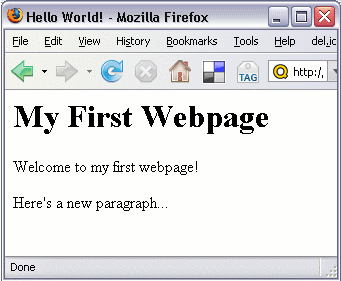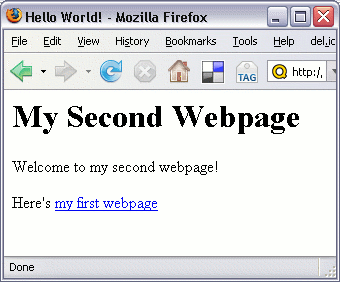How Do You Upload Your Own Code to a Domain in Google
How to Code Your Own Website
The thought of building a website from scratch can be somewhat daunting for beginners. But it doesn't need to be. In fact, coding a basic website can be extremely uncomplicated, as long as you know a few HTML tags.
Here I testify you how to lawmaking your own website, so publish it to the web. Information technology won't take long either. As y'all'll soon detect, building your own website is much easier than it sounds!
What is a Website?
Before we make our own website, we should understand what a website really is.
A website is just a collection of spider web pages. The web pages are usually linked together, but not always. To build a website, you simply create ane or more web pages.
In gild for the globe to see it, the website (or collection of spider web pages) needs to be hosted on a web server. This web hosting is normally done past a hosting provider (otherwise known as a hosting company or web host). A hosting provider is simply a company that provides web hosting to their customers.
What is a Spider web Page?
A web page is a text file that contains a combination of text and "markup" code. When the document is viewed in a web browser, it displays (or "renders") every bit intended. When it is viewed in a text editor (such every bit Notepad), information technology displays the text and markup code.
Therefore, a web page consists of 2 views:
- The "rendered" view - This is what y'all come across when you view the spider web page in your browser.
- The "source code" view - This is the "backside the scenes" code that specifies the content and how the page should appear.
You tin can view the source code of any spider web folio on the spider web. The source code will usually open in a new tab.
To do this, use your browser's View Page Source feature. For example, if you utilise Google Chrome, go View > Developer > View Source. If you lot apply Firefox, become Tools > Web Programmer > Page Source. Depending on your device and browser, y'all might also be able to right click anywhere on the page to bring upwardly the View Source selection.
The source code of a web page is fabricated up of HTML tags. Some tags are mandatory (all web pages must use them), simply most tags are optional. The actual tags that you utilize will depend on the content y'all want to appear.
Have a await at the following lawmaking.
Lawmaking Case ane:
The to a higher place code can be a template for any web page. If you view the source code of any web folio, you should find these tags. You might need to search for them, but they should be there.
You should be able to see the html tag near the top, and the </html> nigh the bottom. This is because all other HTML tags must go in betwixt the html and </html> tags. (The simply exception to this is the <!DOCTYPE...> tag, which specifies the version of HTML/XHTML the document is using. We won't go into this tag here, just if y'all're interested, hither's more info).
The body tags incorporate all content to be displayed on the page. For instance, if y'all wanted to display the words "Welcome to my web page", you would need to place them in between the trunk and /body tags.
Here's another example. This time, let's add some content.
Code Example 2:
If you lot were to open the in a higher place HTML file in your browser, it should await something like this:

As you can see, whatever text surrounded by h1 and /h1 appears as a heading (heading level one to be exact). The text within the p tags displays as normal paragraph text. You tin add equally many HTML tags as you similar to a web page.
In that location are many more HTML tags (more than 100). Some tags are used for formatting (like h1), other tags are used for displaying objects (such as images, forms, tables, etc).
How do I apply this Code?
So far I've showed you the lawmaking used to create a basic spider web folio. I've also showed you what that web page looks similar in a browser. At present I'thou going to show you how to do this yourself.
To create a web folio like the above instance, practice the following:
- Open up a text editor (such every bit Notepad or Simpletext) or HTML editor
- Open a new (blank) page (eg, File > New...)
- Copy the code from Code Instance 2 and paste it into your blank text file (or re-type it if you prefer)
- Save the file every bit index.html (have note of where you lot saved it)
Congratulations! You lot just created your first web page!
Now, you can go ahead and view your new web page in your browser. To practice this, you lot can double-click on the file. If this doesn't work, try opening a new browser window, then dragging the file onto information technology. Otherwise, depending on your browser, you should be able to get File > Open...
Adding another Web Page
Calculation another web page is simply every bit piece of cake as creating your showtime one. In fact, you could just brand a re-create of your offset one if you wanted, so modify it as you wish. For instance, y'all could create a hyperlink so that the two pages are linked. That way, clicking on the link will display the other page.
So, let's create another web page. On this web page, we volition have a hyperlink that points to our first web page. To do this, our lawmaking would look something similar this.
Lawmaking Example three:
The above HTML folio will look like this in a browser:

And so, go ahead - create your 2d web page. This time telephone call it, say... page_two.html.
And then, in case yous've forgotten how to do this, here are the steps for creating your second web page:
- Open up a text editor (such every bit Notepad or Simpletext)
- Open a new (bare) page (eg, File > New...)
- Copy the code from Lawmaking Example three and paste information technology into your blank text file (or re-type it if yous prefer)
- Save the file as page_two.html (relieve it into the aforementioned directory equally your previous file)
Congratulations! You've just created your second web folio. You could say that you've created your first website!
Calculation More Content to your Web Page
At present that you've made your first website, you can add as much content as you wish. For case, you lot could add more text and format it, y'all could add class elements, images, and much more.
Quackit provides lots of HTML codes that yous tin can copy & paste into your own spider web pages. These are bachelor at the HTML code library and the HTML examples page.
Experience free to copy/paste any of these HTML codes into your own web page and change them every bit you wish. Don't exist afraid to experiment.
Set up to Publish Your Website?
Everything you've done so far has been on your local computer. The only people who can view your web page are those with access to your computer.
To publish your website for the world to run into, you'll need to "upload" your website to a website hosting provider's server. To do this, you need to open an account with a web hosting provider. One time you've done this, you'll be able to give out your ain ".com" address to anyone you want to view your website.
Opening a hosting account is normally directly forward. The hardest function is often deciding which hosting plan to use. If you're merely starting out, a basic hosting plan is usually sufficient.
So, to publish your website, yous but:
- Open an account with a hosting provider
- Upload your spider web folio/due south (your web host volition explain how to do this once you sign upwardly)
It's that simple!
Our partner site, ZappyHost provides not bad hosting plans for beginners right through to professionals. (Full Disclosure: ZappyHost is a partner site and I earn a commission from whatsoever product sales).
For now, the Linux Economic system programme should be more than than enough. It'due south the cheapest plan simply you get loads of features and sufficient deejay space. If you have lots of photos/images for your website, you lot might be better off with a Deluxe or Premium plan, equally these plans provide much more disk space.
If you lot prefer to store around first, check out my Spider web Hosting Tutorial. This tutorial explains in more detail, what web hosting is, and how to choose a hosting provider.
Online Website Builders
I realize not everyone wants to spend the time learning HTML etc in order to make their own website. Many people but need to go a website up and running ASAP without getting all technical!
If that sounds similar yous, this online website builder by ZappyHost was made just for you! This is a tool that allows yous to create a website within minutes. Merely choose a template, add content. It's that uncomplicated. Of class, you tin customize your template by uploading your own images or selecting from the thousands of stock photos.
And get this... hosting and domain proper noun is included absolutely FREE! If y'all like the sound of that, check it out!
(Full Disclosure: ZappyHost is a partner site and I earn a committee from any product sales).
More Resources
Here at Quackit yous'll find thousands of pages of useful info regarding building websites. Beneath are some y'all might find useful for making your own website:
- The Create a Website Tutorial outlines the two main approaches to creating a website (i.e. code information technology yourself or use a website builder). This commodity shows y'all how to save money on a website builder business relationship, likewise equally getting a free domain name in the procedure!
- The Build a Website Tutorial is a cracking folio to bookmark. It is the main entry betoken into all the tutorials regarding website development.
- Equally mentioned, we've got Re-create/Paste HTML Codes and HTML Examples that y'all tin can use to re-create and paste into your own web pages.
- And, you can e'er check out the Quackit homepage for a quick glance at what you lot tin discover at Quackit
Source: https://www.quackit.com/make-your-own-website/
0 Response to "How Do You Upload Your Own Code to a Domain in Google"
Post a Comment